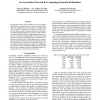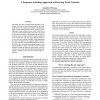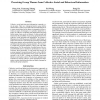AAAI
2015
8 years 8 months ago
2015
Users commonly use Web 2.0 platforms to post their opinions and their predictions about future events (e.g., the movement of a stock). Therefore, opinion mining can be used as a t...
AAAI
2015
8 years 8 months ago
2015
Algorithmic reductions are one of the corner stones of theoretical computer science. Surprisingly, to-date, they have only played a limited role in machine learning. In this paper...
AAAI
2015
8 years 8 months ago
2015
Sequential decision problems that involve multiple objectives are prevalent. Consider for example a driver of a semiautonomous car who may want to optimize competing objectives su...
AAAI
2015
8 years 8 months ago
2015
To judge how much a pair of words (or texts) are semantically related is a cognitive process. However, previous algorithms for computing semantic relatedness are largely based on ...
AAAI
2015
8 years 8 months ago
2015
This paper describes a learning-based approach for automatic derivation of word variant forms by the suffixation process. We employ the sequence labeling technique, which entails...
AAAI
2015
8 years 8 months ago
2015
The abundance of algorithms developed to solve different problems has given rise to an important research question: How do we choose the best algorithm for a given problem? Known ...
AAAI
2015
8 years 8 months ago
2015
AAAI
2015
8 years 8 months ago
2015
AAAI
2015
8 years 8 months ago
2015
Timed Failure Propagation Graphs (TFPGs) are a formalism used in industry to describe failure propagation in a dynamic partially observable system. TFPGs are commonly used to perf...
AAAI
2015
8 years 8 months ago
2015
Lifschitz and Turner introduced the notion of the splitting set and provided a method to divide a logic program into two parts. They showed that the task of computing the answer s...



